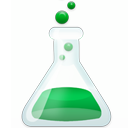IR Spectroscopy of Liquids
Liquid organic compounds can be examined directly as a thin film, "neat", between two NaCl plates. By "liquid organic compound" we mean pure organic compounds that are liquids at room temperature, not solutions of a solid organic compound in a solvent. Although it is possible to run a solution as a thin film between two plates, the resultant spectrum would show bands of both the compound of interest and the solvent.
 |
Obtain two salt plates from the desiccator in the main fume hood in your lab. Ideally, the plates will already be clean. If necessary, clean the plates with a small amount of acetone. The plates should also be transparent, but quite foggy plates usually give acceptable spectra. |
 |
Use a Pasteur pipet to place a drop of your liquid unknown on one salt plate. |
 |
Put the second salt plate on top so that the liquid spreads into a thin film. When running a liquid sample, you need to have two plates, both to prevent the liquid from running off the plate and to prevent it from evaporating. |
 |
Pick up the plates and take them to the IR. Carry them by the edges and/or wear gloves. (Gloves are advised because sometimes the liquid compound leaks out from between the plates.) |
 |
Take the plates to one of the FT-IR instruments and place them in the V-shaped sample holder inside the instrument. Obtain the IR spectrum. Once you have obtained your spectrum, clean the salt plates again with acetone and return them to the desiccator. |
Back to IR Spectroscopy
